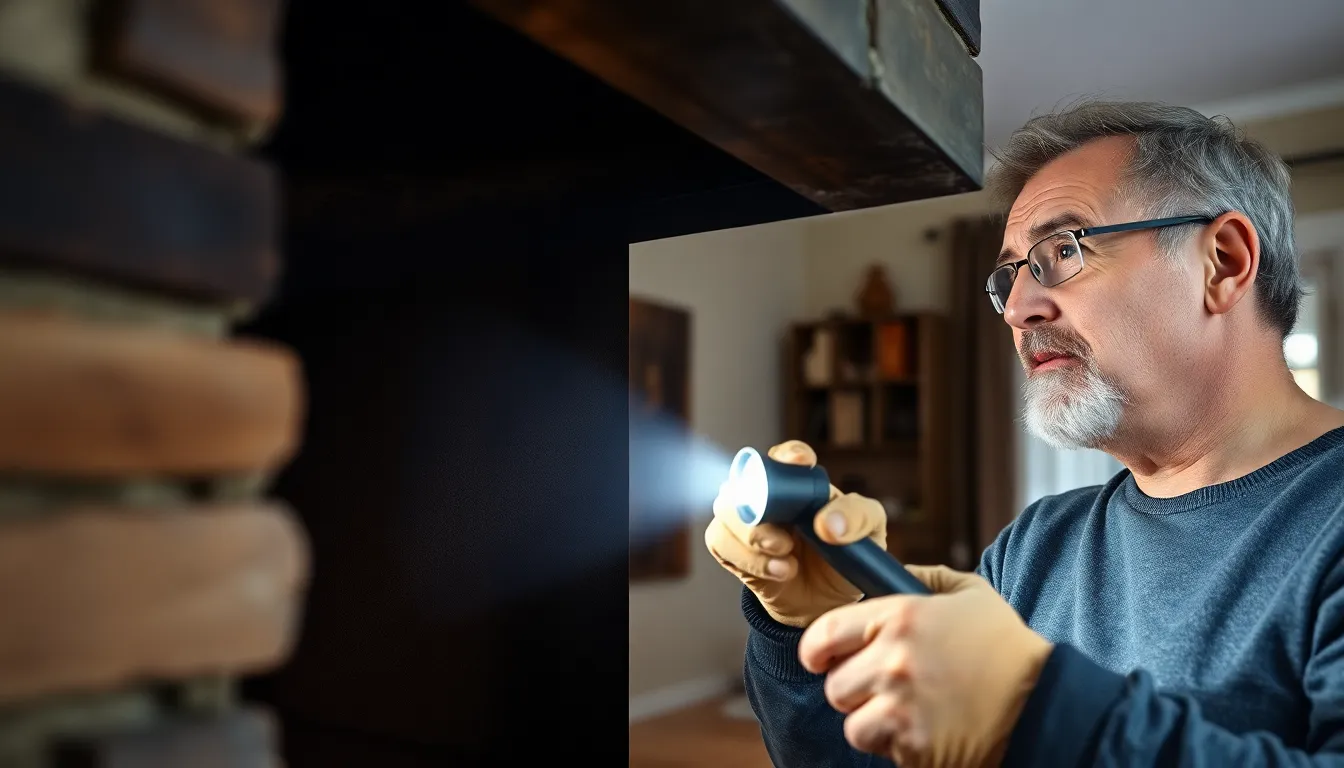When was the last time someone peeked into your chimney? If it’s been a while, you might want to schedule a cleaning before it turns into a cozy home for raccoons or a fire hazard. Chimney cleaning isn’t just a chore; it’s a vital part of home maintenance that keeps your fireplace roaring safely and efficiently.
Table of Contents
ToggleImportance of Chimney Cleaning
Regular chimney cleaning holds significant importance to home safety and efficiency. Homeowners must prioritize this maintenance task to avoid various hazards.
Preventing Fire Hazards
Fire hazards increase when creosote builds up in chimneys. Creosote consists of flammable substances that can ignite, leading to dangerous chimney fires. Each year, thousands of homes suffer damages due to such incidents. Cleaning removes this volatile residue, decreasing the chances of fire. Routine inspections allow for early detection of other potential risks. In 2020, the National Fire Protection Association reported that 27% of chimney fires originated from insufficient cleaning. Homeowners should schedule cleanings annually to ensure their safety.
Maintaining Indoor Air Quality
Indoor air quality significantly deteriorates when chimneys aren’t cleaned regularly. Blocked flues can cause smoke and harmful gases to infiltrate living spaces. These toxins contribute to respiratory issues and other health risks. For instance, carbon monoxide, a dangerous byproduct of combustion, can lead to severe health consequences. Routine chimney maintenance mitigates these risks by ensuring proper ventilation. The Environmental Protection Agency emphasizes regular chimney cleaning as essential for maintaining clean air. Homeowners should consider this vital task part of their overall home maintenance strategy.
Signs Your Chimney Needs Cleaning

Several indicators signal that a chimney requires cleaning. Homeowners should remain vigilant for these signs to maintain safety and efficiency.
Soot Buildup
Soot buildup occurs as wood or fuel burns in the fireplace. Creosote, a byproduct of combustion, accumulates on flue walls and can ignite. The National Fire Protection Association reports that creosote buildup contributes to 27% of chimney fires. Homeowners often notice black, shiny deposits on chimney surfaces or within the flue. Increased soot may indicate insufficient cleaning and a higher risk of chimney fires. Regular inspections help detect soot levels, ensuring timely cleaning and maintaining safety.
Unpleasant Odors
Unpleasant odors suggest a chimney requires attention. A strong, acrid smell may emanate from creosote deposits or blockages in the flue system. Damp conditions often exacerbate this issue, causing musty smells that linger in living spaces. Homeowners may also observe odors intensifying during use, indicating a need for immediate cleaning. Ignoring these odors can lead to hazardous situations, including smoke infiltration and health risks. Regular maintenance ensures that odors remain minimal and that the chimney operates efficiently.
DIY Chimney Cleaning Techniques
Homeowners can effectively clean their chimneys using simple techniques. Following proper steps ensures safety and efficiency.
Tools You’ll Need
Gather essential tools for chimney cleaning. Brushes with stiff bristles remove creosote and soot. A ladder provides access to high chimneys. Wear a dust mask to protect from harmful particles. A vacuum helps collect debris after cleaning. Use a flashlight to inspect the flue for blockages.
Step-by-Step Process
Begin cleaning from the top of the chimney. Attach the brush to a sturdy pole, then scrub the flue’s walls thoroughly. Move the brush up and down to dislodge built-up soot. Check for soot accumulation, and repeat if necessary. After cleaning, use the vacuum to remove loose debris from the firebox. Inspect for cracks or damage before concluding the process. Regular maintenance keeps the chimney functioning safely.
Professional Chimney Cleaning Services
Professional chimney cleaning services offer expertise essential for maintaining safe and efficient fireplaces. These services ensure thorough inspections and detailed cleanings, addressing buildup that poses fire hazards.
What to Expect
Homeowners can anticipate a comprehensive assessment of the chimney’s condition during a professional visit. Technicians typically employ specialized brushes and vacuum systems to remove soot and creosote. The process includes inspecting for structural integrity, identifying blockages, and ensuring proper ventilation. Services often involve a detailed report, indicating areas that require attention or preventive measures. The National Fire Protection Association recommends annual cleaning for optimal safety and performance.
Choosing the Right Service
Selecting an appropriate chimney cleaning service requires careful consideration. Look for certified professionals with positive customer reviews and extensive experience. Verify that they hold proper licensing and insurance, protecting against potential damage during the cleaning process. Compare quotes and inquire about their techniques and equipment used. Additionally, ask about follow-up services, as regular maintenance plays a vital role in chimney safety and efficiency. Investing time in choosing the right service enhances safety and enhances fireplace performance.
Frequency of Chimney Cleaning
Regular chimney cleaning plays a critical role in maintaining fireplace safety and efficiency. Homeowners should consider various factors when determining their cleaning schedule.
Factors Influencing Cleaning Schedule
The type of fuel used in the fireplace significantly impacts the cleaning frequency. Wood-burning fireplaces often accumulate creosote more quickly, requiring more frequent cleanings compared to gas or pellet appliances. Additionally, the frequency of fireplace use matters. Heavy usage necessitates more regular cleanings, while infrequent use may allow for longer intervals. Environmental conditions also contribute; homes in areas with dry climates often encounter increased creosote buildup. Lastly, the presence of wildlife, such as birds or squirrels, can indicate a need for more frequent inspections and cleanings.
General Guidelines
Experts recommend scheduling annual chimney cleanings for optimal safety. This guideline holds even if the chimney shows no visible signs of trouble, as many issues remain hidden. Homeowners should prioritize cleaning before the heating season begins to prevent fire hazards during use. Those who frequently burn wood should consider scheduling cleanings twice a year. Furthermore, if signs of creosote buildup, such as black gooey deposits or strong odors, become apparent, homeowners must act quickly to address the issue. Following these guidelines helps ensure a safe and efficient fireplace operation.
Regular chimney cleaning is essential for maintaining a safe and efficient fireplace. By prioritizing this task, homeowners can significantly reduce the risk of fire hazards and improve indoor air quality. Ignoring the signs of a dirty chimney can lead to serious health risks and costly repairs.
Whether opting for DIY methods or hiring professionals, staying proactive about chimney maintenance ensures peace of mind. Investing in regular inspections and cleanings not only enhances safety but also contributes to the overall performance of the fireplace. Homeowners should embrace these practices as integral to their home care routine, safeguarding their families and properties for years to come.


